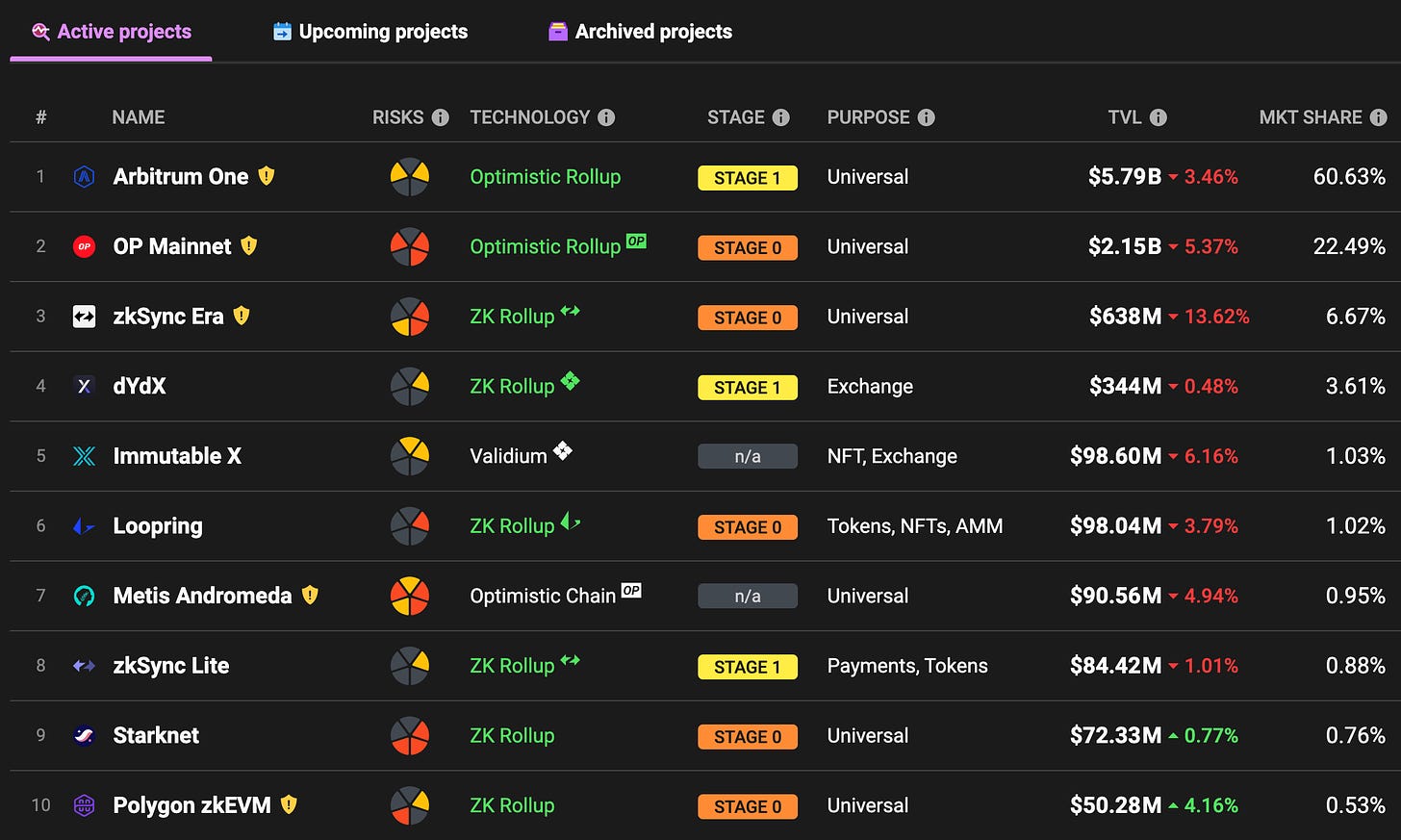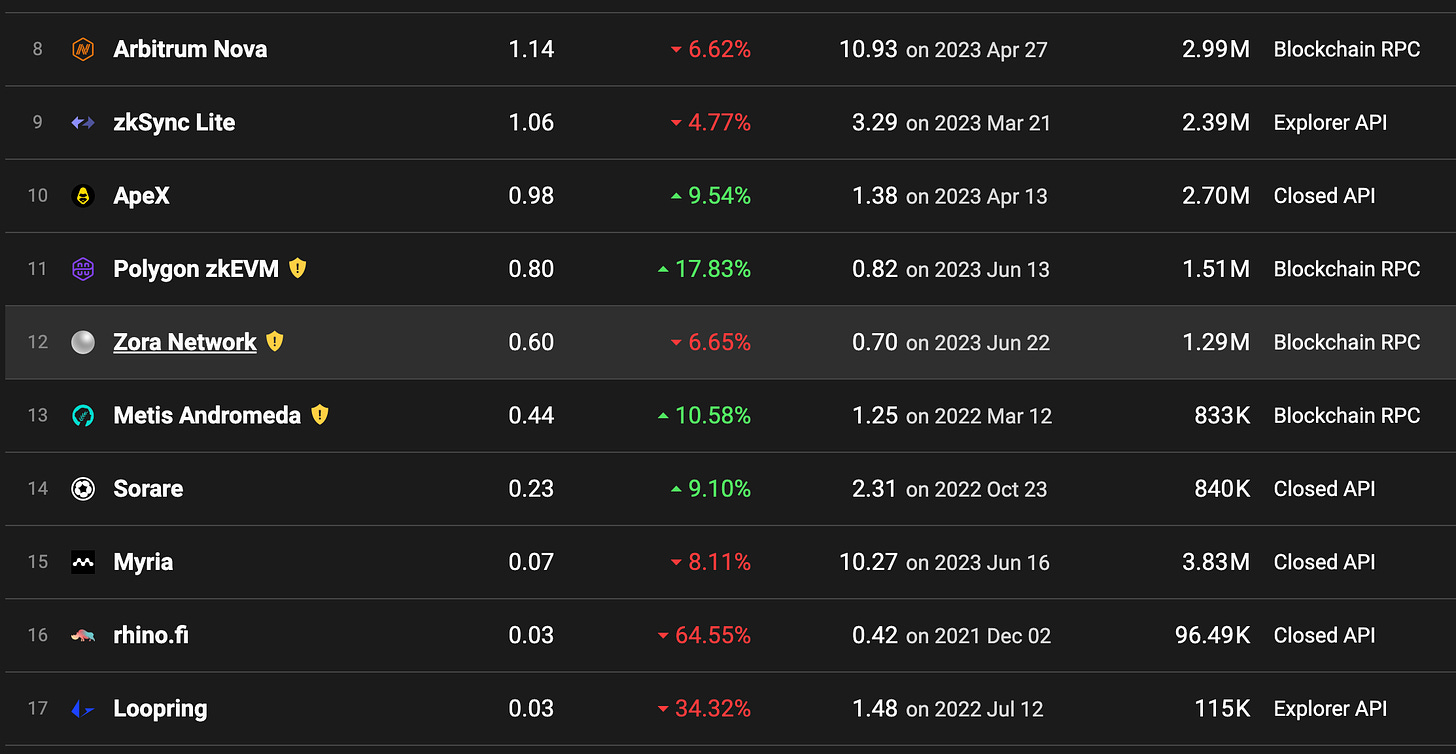Weekly Rollup #22
Axiom hits mainnet alpha | Loopring L3 deploys | Should rollups use PoS? | How L2s accrue value to L1s | Week ending July 7th
👋 Welcome to Modular Media! We cover news, updates, educational content, and more within the modular blockchain ecosystem.
Subscribe to get posts sent directly to your email every week, and follow us on Twitter for modular-related updates!
This week’s issue covers:
Modular Cloud is reimagining developer tools and cloud services for the modular blockchain stack. Get in touch to learn more about Modular Cloud's product offering today, including the world's first block explorer for modular blockchains.
📣 News & Announcements
Axiom Launches Alpha
Last week, Axiom announced its mainnet alpha launch, introducing a new, trustless way for developers to access on-chain data and compute on Ethereum.
The problem
As most of you know, Ethereum is powered by the EVM, which essentially is the software responsible for executing the smart contracts deployed on top of Ethereum and computing the current state of the network (it’s what the nodes run).
The problem was that “prior to Axiom, there was no simple way for smart contracts to trustlessly access historic on-chain data”. Why? Because the EVM can only access the current state, not historic data.
Axiom founder used Opensea as an example to show how the solution works during this podcast episode with the Zero Knowledge Podcast team. When you go to the Opensea site and click on a certain project, say BAYC for example, you’re provided with different information about that specific collection, such as volume, transactions, owner, etc (see here). Of this data, the only piece Opensea is able to gather trustlessly is the current owners. Recall that the EVM can only access the current state, not historic data. Essentially, we’re trusting that Opensea is getting correct data from the archive nodes they query information from.
So how does Axiom make this trustless now?
With some zk magic.
What is Axiom
Axiom is the first ZK coprocessor.
The way this works is that developers can query any of Ethereum’s historic data (going all the way back to the genesis block) from Axiom and also have them perform some sort of processing (off-chain) on top of this data (an action).
Once Axiom generates the result, they stick a validity proof (zk) on it to verify that they did everything correctly - so that (1) they used correct data to begin with, and (2) the computing was correctly done.
This proof is then verified by Axiom’s smart contract that is deployed on Ethereum, and then finally, the result is returned to the original team that first made the query request.
Computing off-chain, and results on-chain.
Use Cases
Some of the use cases provided by the Axiom team include:
Digital Identity (DID)
Trustless oracles
On-chain coordination
& ZKML
You can check out the complete article to learn more about these use cases.
What’s Next
The team has already published a couple of demos if you’re interested in playing around - there’s one for protocols to check out, one for oracle solutions, and one for anyone else (check out your account age).
Axiom will be sharing more about its roadmap and solution over the coming months, so be sure to follow them on Twitter to stay in the loop. If you’re a developer and want to start building on Axiom, you can check out their docs or join this TG group to ask for further assistance.
Loopring L3 Deploys on Taiko Testnet
Last week, Loopring announced the deployment of their L3 rollup on top of Taiko’s L2 zkEVM testnet (”alpha-3”). This is quite a mouthful, so let’s break this down a bit.
What is Loopring
As a quick refresher, Loopring originally launched as an L2 - in fact, it was the first zk-rollup to launch on Ethereum.
That being said, this L2 network was not able to achieve much user activity, especially when compared to other L2 networks like Arbitrum or Optimism.
When it comes to TVL:
When it comes to monthly transactions:
So why launch an L3?
According to the team, Loopring wanted to offer its users increased scalability & lower costs with the help of recursive proofs, which as a reminder, like generating a proof of a proof. So in this case, Loopring L3 generates its own proofs and sends them for verification on the L2 (Taiko zkEVM). Then, these proofs are condensed on the L2 by generating a proof of these L3 proofs. From here, a single proof gets sent to Ethereum L1 for finality.
While deploying on an L3 will offer increased scalability, @sassal0x from The Daily Gwei brings up a good point in that it seems as though Loopring wants to take advantage of Taiko’s growth over the coming year, as the network approaches its own mainnet launch. He also mentions that he thinks Loopring will get rid of its L2 network at some point in the future, and focus only on growing the L3. This will allow Looping to focus on building the best user experience possible, with the help of its smart contract mobile wallet, while letting Taiko worry about providing the best rollup infrastructure possible.
But why launch an L3 on top of Taiko’s zkEVM instead of an existing zkEVM, such as zkSync’s or Polygon’s? Well, a couple of the core members from the Loopring team ended up leaving the team to start working on Taiko - so you could say the relationship is strong between the two. Plus, Taiko aims to become a true type-1 zkEVM, which would allow developers to launch their already existing Ethereum dapps on Taiko without changing the smart contracts.
The hope is that due to this ease of deployment, teams will move to Taiko once they launch on mainnet, and users will follow because of the superior user experience provided by Loopring’s wallet, which is very smooth by the way. You can onboard funds through a card or Apply Pay, you can set limits on daily transfers, swap & trade, send, receive, and manage your NFTs, stake your ETH, and more.
What’s next
Users can download the Loopring wallet today and start interacting with the testnet. You can follow the team on Twitter to keep up with their future announcements or join them on Discord to ask any questions you may have about this new L3.
More News & Announcements
Celestia’s public testnet upgrades to Oolong, bringing a new set of features for developers, including an increase in block space for blob data, “restricted block size”, which allows the Celestia community to set their preferred block size through on-chain governance, a “blob module” for rollups to prove their data inclusion on the network, and more.
Introducing the Public Goods Network, a joint collaboration effort including names like Gitcoin, Protocol Guild, Public Nouns, Giveth, and more. The PGN will be its own L2 rollup built with the OP Stack (thanks to Conduit’s rollup deployment solution), which means it’ll be part of Optimism’s Superchain, and is meant to provide a sustainable funding mechanism for public goods across Ethereum.
Here are the details about Inborg, a new Polygon PoS upgrade coming this year to help enhance network stability and increase finality time. The upgrade is based on two different PIPs: PIP-11 (Aalborg), and PIP-12 (Indore), and is a response to the recent block reorgs the chain experienced this year.
Lido brings stMATIC to the Coinbase Wallet.
IDEX announces XChain, an L2 supernet (an appchain on Polygon) dedicated to its defi ecosystem. This chain is currently live on testnet.
Starknet’s new Quantum Leap upgrade hits testnet, bringing a 10x throughput improvement to the network. It looks like the upgrade is expected to hit mainnet soon, assuming Starknet delegates vote in favor of so.
Blockframe (an NFT marketplace on zkSync) introduces the “Bulk Semaphore” protocol, which enables bulk, anonymous NFT auctions.
AIP-1.1 passes. This means 700M $ARB tokens will go to a vesting contract, to be distributed over a four year period to the Arbitrum Foundation.
Entangle protocol, and Dodo (DEX aggregator) both launched on Scroll (L2 network) this past week.
Fuel is live on Guildxyz (web3 community platform) - go complete some tasks.
Check out Mantle’s (Ethereum L2) Q2 milestones, including development and performance updates across the network.
New Mantle proposal up for voting, MIP-24 Mantle EcoFund. “This proposal aims to catalyze a capital pool of $200 million, to be deployed within the Mantle Ecosystem over the next 3 years.” Everything you need to know about the proposal is summarized here for you.
Here are Eclipse’s developments throughout the month of June, including the new Constellation Chart, two new ecosystem projects (Wynd & Plural Energy), and a proposal to launch an SVM rollup on top of the Algogrand L1 chain.
SupraOracles can now be leveraged by Caldera chains.
Dymension integrates Avail DA into its rollup framework SDK solution. Now, developers can choose whether they would like to use Celestia or Avail when it comes to DA.
Bullieverse is building its own rollup using Eclipse’s 1-click RaaS solution.
Here’s the latest “State of Hyperlane” issue, including Waterloo Hackathon results, new branding, a new framework, the first Solana <> EVM Hyperlane message, and more.
Arjun from Connext proposes ERC-7281, which aims to enable standardized liquidity across chains, as a response to the recent Multichain hack.
Stableswaps are live on Catalyst now! Check out the link to learn how you can try out the cross-chain liquidity protocol yourself.
Here is a list of new projects that have deployed on the Omni Network testnet.
“EigenLayer to Increase Restaking Capacity”.
Aragon just launched this awesome feature that allows any existing DAO to import their already existing DAO token. In other words, migrate governance to the Aragon app in just a few clicks, with no code. The platform also includes tools like subDAO creation and token wrapping/unwrapping.
Succinct’s Ethereum light client has been integrated to secure the Gnosis Omnichain Bridge.
Toki and Noble partner to bring Japanese stablecoins to the Cosmos. A thread on why this is great for the interchain (shout out @73lV_)
Check out the first list of speakers for Cosmoverse 2023 - some very recognizable names.
Introducing Archway, a new Cosmos L1 appchain that is meant to provide value back to the projects deployed on the L1 based on user activity.
The USDT stablecoin hits the Cosmos.
Neutron, Long Hash, and the ATOM Accelerator announce the AEZ Accelerator, “Scheduled to start early September, the AEZ Accelerator will offer 25-30 teams a 12-week program with two tracks, providing knowledge, funding, and a strong network for successful project launches on Neutron and other Cosmos blockchains”.
New consumer chain draft proposal by EntryPoint (thematic indexes to help bring institutions to the Hub’s economic zone). In exchange for the Hub’s security, along with $2.5M investment in the chain, Entry Point proposes to provide the Hub with 10% of $ENTRY block rewards, governance power, and to have $ATOM be the default gas token for the chain. You can check out the complete draft to learn (linked above) all about the proposal.
Osmosis introduces an Aggregated Limit Order Book, which introduces a new set of features for traders, including a view of all Osmosis liquidity (like a traditional order book CEX), customized denomination of liquidity, and limit orders. Plus, Levana Protocol will launch on Osmosis, bringing perps to the network. Osmosis just keeps building!
📚 Discourse & Education
Should rollups use PoS?
One goal of all major rollups is to progressively decentralize their sequencers. This can be done in several ways, but one commonly discussed approach is using Proof-of-Stake (PoS). The idea is similar to how PoS works in L1 blockchains (there are actually a few ways PoS can be used for rollups, but we won’t get into that now).
However, not everyone thinks this is a good idea. Last week, Jon Charb from DBA suggested that rollups should not have any form of staking, but are better served using Proof-of-Authority (PoA). He specifically mentions “governance electing delegates to run PoA/simple round robin style”.
Where is this coming from? I thought we didn’t like PoA?
It’s unlikely that Jon or anyone who cares about decentralization would argue that PoA is ideal, but the above perspective is at least in part a response to the amount of ETH in LSTs. As a reminder, LST stands for Liquid Staking Tokens and exists to give stakers better liquidity. TLDR without LSTs your staked ETH is locked. You earn yield but you can’t do anything else with it. With LSTs you can stake AND do other things with that “same ETH”, like put it in DeFi.
So what’s the problem?
The problem is that LSTs are extremely compelling, but come with a big tradeoff. If 100% of ETH is given to LST providers such as Lido, it’s the LST governance that decides who the actual consensus participants are. Jon’s argument is that this is effectively no different than rollup governance doing PoA, AKA deciding who the consensus participants are. In fact, he even goes a step further and suggests that rollup PoA could be more decentralized than rollup PoS. Governance can select a distributed set of entities who each have equal voting power, whereas in PoS these things are harder to ensure and could actually end up more centralized.
As always, there are tradeoffs, and Jon acknowledges that the PoA approach sacrifices permissionlessness.
How L2s accrue value to L1s
There is a common debate across ecosystems about whether L2s are symbiotic or parasitic to L1s. The basic parasitic argument is straightforward - L2s steal traffic from L1s and don’t offer much in return. The argument typically assumes inelastic demand.
Ok, so what’s the symbiotic argument?
There are actually many different ways in which L2s accrue value to L1s! Last week, Ryan Berckmans did a great job outlining them.
He refers to “touchpoints” between L2s (he also includes L3s) and L1s, grouping touchpoints in two buckets:
Necessary touchpoints: Necessary for the L2/L3 to function
Adjacent touchpoints: Not strictly necessary for L2/L3 operation
Two examples of necessary touchpoints are settlement state root updates and data blobs. The alignment between layers here is simple - more L2/L3 growth, more updates and data blobs consumed. Two examples of adjacent touchpoints are L2-to-L2 bridging (eg. via merkle roots etc passed through L1 messages) and L1-to-L2 deposits / withdrawals.
Ryan unpacks more examples and in greater depth, so we recommend giving his post a read!
More Discourse & Education
Umbra Research breaks down Shared Validity Sequencing ✍️🔥
@nickwh8te summarizes Umbra Research’s post 💬👆
Sovereign Labs explains how ZK single-round fraud-proofs work 💬🔥
@udiWertheimer discusses what Bitcoiners can learn from Ethereum with Vitalik 🎙️
@0xidanlevin explains a key risk that restaking protocols pose to Ethereum decentralization and offers an economic solution 💬 💎
@13yearoldvc breaks down “42 Restaking Rabbit Holes" and how crypto will be forever changed 💬🧠
@AlanaDLevin walks through the tradeoff between connectivity and control in app-specific rollups ✍️
@ether_fi discusses staking, NFTs and Ethereum ecosystem events with Sreeram from EigenLayer, Stephy from Messari and others 🎙️
- explores how bridges connect blockchains (Part 2 of his series) ✍️
@specialmech discusses What Censorship Can Do For You with Sreeram from EigenLayer and Elijah from Duality 🎙️💎
@ryanberckmans highlights ways in whichs validiums are L2 and how Polygon maintains Ethereum alignment 💬
@gitpusha explains his recent proposal for GEL Staking Economics V1 💬
@DrewVdW and @alexmatthews95 explore the open design space for blockspace derivatives and selling future blockspace ✍️
Kakarot discusses the history behind the project with their co-founders and Starknet community members 🎙️
@expctchaos unpacks trust-minimized bridging and cross-chain interoperability 💬
@thePalenimbus explains Interchain Intents and how Hyperlane relates ✍️
@abondar92 summarizes the recent Celestia Twitter Space exploring ZK proofs in the modular stack 💬
Ingonyama explains their zero-knowledge processing unit ✍️
@odin_free creates a new Starknet ecosystem map 🖼️
@francescoweb3 walks through how to create an L3 using Arbitrum Orbit 💬
@N1C0_B_ explains Polymer and how it expands IBC outside of Cosmos 💬
@Hercules_Defi explores the evolution of Superchains - Cosmos, OP, zkSync and more 💬
@guywuolletjr walks through tips to avoid token design failure modes ✍️
That's all for this week! Thanks for reading 🧱🎬
If you found this issue useful, please share this tweet so more people can see it.







